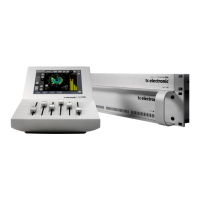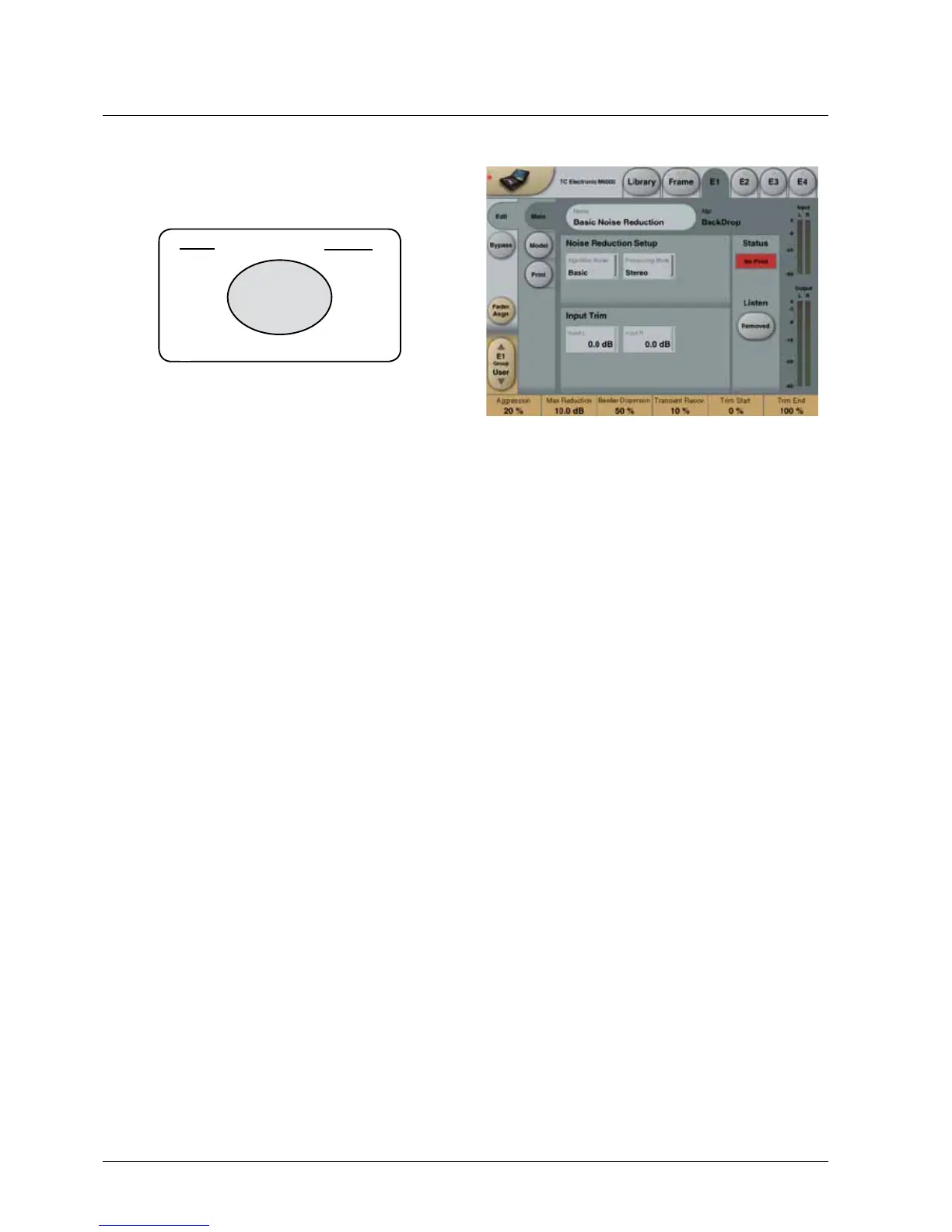102
bACkDrOP
The BackDrop algorithm occupies:
@ Normal Sample Rate : 1/4 DSP Resource
@ Double Sample Rate : Not available
Algorithm Inputs/Outputs are distributed as follows:
E1 - E4
L
R
L
R
INPUT
OUTPUT
•
•
•
•
•
•
•
•
•
•
•
•
•
•
•
•
Main
BackDrop’smainscreenallowsyoutosetcertainglobal
parameters.
Algorithm Model
Allows you to select between the Basic, MultiBand and
MultiType algorithm models. These models are described
below in detail. You can instantly switch between models at
any time and the settings for each model are recalled.
Processing Mode
The Processing Mode control allows you to alternate
betweenBackDrop’stwomodesofoperation-Stereo
orM/S(mid/side).InStereomode,BackDropassignsa
separate noise reduction process to the Left and Right
channelswhileinM/Smode,BackDropassignsanoise
reduction process to the Mid signal and another to the Side
signal.Forcertainstereoaudiosequences,operatingin
M/S mode can give better results than when operating in
Stereo mode. It should be noted that when you change the
ProcessingMode,BackDropautomaticallyrecalculatesthe
noise print information for the current operating mode.
Left and Right Input Trim
The Left and Right Input Trim controls allow attenuation of
the incoming signal level. The left and right signals can be
independently attenuated by as much as 12 dB. In order
to get the maximum internal processing resolution from
BackDrop,theInputTrimcontrolsshouldbesetto0dB.
Status
On the right side of the screen is a panel which is visible
onallofBackDrop’sscreens.Atthetopofthispanelisa
region which displays the status of the noise print (No print,
Calculating,RunningorError).InorderforBackDropto
operateproperly,theword“Running”mustappearinthe
status window, indicating that a valid noise print is available.
If“NoPrint”appearsinthestatuswindow,thenyouhavenot
yetcapturedavalidnoiseprint.Iftheword“Error”appears
then the sampling rate has changed since you captured your
noise print.
Introduction
TheBackDropnoisereductionsystemwasdesignedto
provide the maximum amount of noise reduction without
audibly altering the underlying signal. Since noise removal
systemscanalsoremovepartofthesignal,BackDrop’s
fundamental philosophy is to remove the noise with as little
processingaspossible.Thatis,BackDropmonitorsthe
incoming signal and continuously decides the perceptually
optimal processing to apply. This is accomplished using
advanced mathematical algorithms resulting from more
thansevenyearsofresearch.BackDrop’sthreepatented
algorithm models allow you to apply the processing with
surgical precision while leaving the music undisturbed.
BackDropletsyouchoosethealgorithmmodelthatbest
suits the noise you want to reduce.
BackDrop’sBasicmodelprovidesasimplesetofcontrols
that are perfect for removing common broadband noises
such as tape hiss. The MultiBand model expands your
control by allowing you to divide the noise reduction
process into three independent frequency bands. This
gives you full control to shape the noise reduction across
frequency in such a way that you can maximize the
noisereductionwithoutdamagingthesignal.Finally,
the MultiType model separates the noise into three
components (Buzz, Room, and Hiss) and lets you choose
how much of each noise component to reduce.
BackDropwasspecificallydesignedtoremovenoises
foundintoday’sworld(humsandbuzzes,roomrumble,air
conditioning systems, tape hiss, etc.) and is not intended to
beusedforremovingclicksandpops.
As an integral part of each of its three algorithm models,
BackDropincludesacomplexmodelofthehumanauditory
system.BackDropcontinuouslylistenstotheincoming
signal and removes only the parts of the noise that the ear
canhear.BackDropofferstwouniquecontrols(Basilar
DispersionandTransientRecovery)toadjustcertain
parametersintheearmodel.Theearmodelisanotherkey
componentinBackDrop’sphilosophyofapplyingaslittle
processing as possible to the incoming signal so that only
the noise is removed, not the music.

